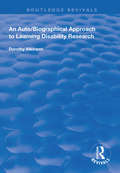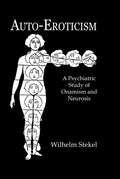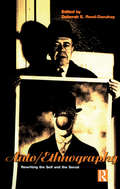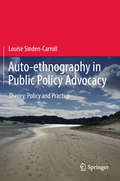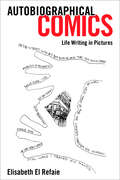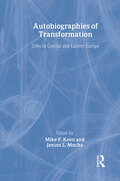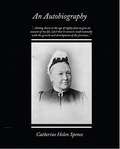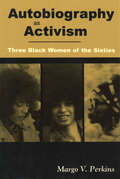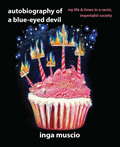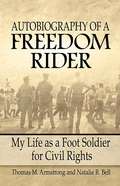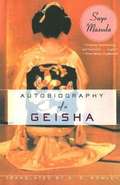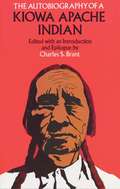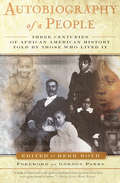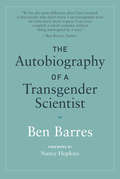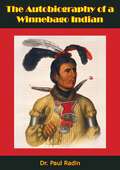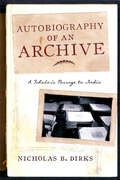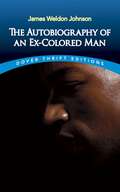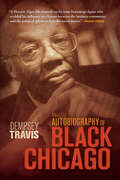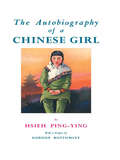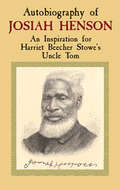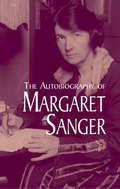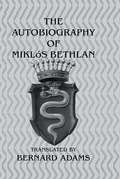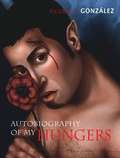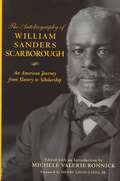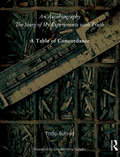- Table View
- List View
An Auto/Biographical Approach to Learning Disability Research (Routledge Revivals)
by Dorothy AtkinsonFirst published in 1997 , Dorothy Atkinson collects testimonies of the personal perspectives of people with learning disability in order to rediscover the histories of people with learning disabilities. Calling on the importance if auto/biographical research as mode to encourage social, historical awareness and potential understanding of the commonalities as well the differences between people with learning difficulties.
Auto-Eroticism
by Wilhelm StekelWhen this work was first published in the first hald of the last century, sexology and the unprejudiced study of sexual activity was in its infancy. In his study of human sexual behaviour, Kinsey was able to state that the majority of human beings had masturbated at one time or another but to us today this seems quite an astonishing statement to have made. The study of human sexuality was surrounded by ignorance and superstition, and the medical profession was regrettably the worst offender and the most ignored. In such a climate, Dr Stekel’s book was a revelation much ahead of its time. This edition first published in 2005. Routledge is an imprint of Taylor & Francis, an informa company.
Auto/ethnography: Rewriting the Self and the Social
by Deborah E. Reed-DanahayIn departing from the traditional stance taken by anthropologists, who study 'others' ethnographically, this timely book explores forms of self-inscription on the part of both the ethnographer and those 'others' who are studied. Informed by developments in postmodernism, postcolonialism, and feminism, this is an original contribution to the growing dialogue across disciplinary boundaries. The chapters build upon recent reconsiderations of the uses and meaning of personal narrative to examine the ways in which selves and social forms are culturally constituted through biographical genres. Ethnic autobiography, self-reflexivity in ethnography, and native ethnography raise provocative questions about a range of issues for the contemporary scholar: authenticity of voice; ethnographic authority; and the degree to which autoethnography constitutes resistance to hegemonic bodies of discourse. Examined here in a variety of cultural and political contexts, writing about the self offers challenging insights into the construction and transformation of identities and cultural meanings.
Auto-ethnography in Public Policy Advocacy: Theory, Policy and Practice
by Louise Sinden-CarrollThis book explores how public policy advocacy can be used to approach policy issue identification, resolution or, at the least, support the management of wicked policy issues. By describing how this type of advocacy draws on participatory action research, including ethnographic and auto-ethnographic models, this book offers a tool for public policy consumer advocates on how to apply the Human Capabilities Approach to address presenting public policy issues worldwide. By applying these models to the situation of prisoners with hearing loss in New Zealand’s prisons, it identifies multiple causal factors for quality-of-life-limiting marginalization, e.g. social barriers (e.g. disability discrimination); environmental limitations (e.g. geographical and those introduced by incarceration); and individual responses in line with negative attitudes – both social and political, including the State’s denial of prisoners’ right to democratic participation by revoking their right to vote in general elections after sentencing. In addition, two other areas, namely blood safety and broadcast media captioning, are highlighted, showing that the skill of auto-ethnography is transferrable and can be applied to ensure effective consumer advocacy for a diverse range of issues that affect marginalized sectors.
Autobiographical Comics: Life Writing in Pictures
by Elisabeth El RefaieA troubled childhood in Iran. Living with a disability. Grieving for a dead child. Over the last forty years the comic book has become an increasingly popular way of telling personal stories of considerable complexity and depth. In Autobiographical Comics: Life Writing in Pictures, Elisabeth El Refaie offers a long overdue assessment of the key conventions, formal properties, and narrative patterns of this fascinating genre. The book considers eighty-five works of North American and European provenance, works that cover a broad range of subject matters and employ many different artistic styles. Drawing on concepts from several disciplinary fields—including semiotics, literary and narrative theory, art history, and psychology—El Refaie shows that the traditions and formal features of comics provide new possibilities for autobiographical storytelling. For example, the requirement to produce multiple drawn versions of one's self necessarily involves an intense engagement with physical aspects of identity, as well as with the cultural models that underpin body image. The comics medium also offers memoirists unique ways of representing their experience of time, their memories of past events, and their hopes and dreams for the future. Furthermore, autobiographical comics creators are able to draw on the close association in contemporary Western culture between seeing and believing in order to persuade readers of the authentic nature of their stories.
Autobiographies of Transformation: Lives in Central and Eastern Europe (Studies in European Sociology)
by Mike F. Keen Janusz L. MuchaAutobiographies of Transformation is a completely unique history of sociology in Central and Eastern Europe in the post-Communist era. Through the autobiographies of ten key sociological witnesses from the region, the sociological imagination is turned upon itself, resulting in a compelling and revealing account of the struggles, triumphs, and continuing challenges faced. The sociologists examined fall into three cohorts: early, mid and late career. As participants, each of the sociologists included has witnessed the intersection of history and biography in Central and Eastern Europe. As sociologists, they have tried, and continue to try, to connect the two so that they and their fellow citizens may better understand their circumstances and the futures that may follow. This revealing book, ideal for students and researchers of sociology, and Central and Eastern Europe studies, provides powerful and compelling autobiographical accounts, relating them to the current interest in this area's transformation.
An Autobiography
by Catherine Helen SpenceSitting down at the age of eighty-four to give an account of my life, I feel that it connects itself naturally with the growth and development of the province of South Australia, to which I came with my family in the year 1839, before it was quite three years old. <P> <P> But there is much truth in Wordsworth's line, "the child is father of the man," and no less is the mother of the woman; and I must go back to Scotland for the roots of my character and Ideals. I account myself well-born, for My father and my mother loved each other. I consider myself well descended, going back for many generations on both sides of intelligent and respectable people. I think I was well brought up, for my father and mother were of one mind regarding the care of the family. I count myself well educated, for the admirable woman at the head of the school which I attended from the age of four and a half till I was thirteen and a half, was a born teacher in advance of her own times. In fact. like my own dear mother, Sarah Phin was a New Woman without knowing it. The phrase was not known in the thirties
Autobiography as Activism: Three Black Women of the Sixties
by Margo V. PerkinsAngela Davis, Assata Shakur (a.k.a. JoAnne Chesimard), and Elaine Brown are the only women activists of the Black Power movement who have published book-length autobiographies. In bearing witness to that era, these militant newsmakers wrote in part to educate and to mobilize their anticipated readers. In this way, Davis's Angela Davis: An Autobiography (1974), Shakur's Assata (1987), and Brown's A Taste of Power: A Black Woman's Story (1992) can all be read as extensions of the writers' political activism during the 1960s. Margo V. Perkins's critical analysis of their books is less a history of the movement (or of women's involvement in it) than an exploration of the politics of storytelling for activists who choose to write their lives. Perkins examines how activists use autobiography to connect their lives to those of other activists across historical periods, to emphasize the link between the personal and the political, and to construct an alternative history that challenges dominant or conventional ways of knowing. The histories constructed by these three women call attention to the experiences of women in revolutionary struggle, particularly to the ways their experiences have differed from men's. The women's stories are told from different perspectives and provide different insights into a movement that has been much studied from the masculine perspective. At times they fill in, complement, challenge, or converse with the stories told by their male counterparts, and in doing so, hint at how the present and future can be made less catastrophic because of women's involvement. The multiple complexities of the Black Power movement become evident in reading these women's narratives against each other as well as against the sometimes strikingly different accounts of their male counterparts. As Davis, Shakur, and Brown recount events in their lives, they dispute mainstream assumptions about race, class, and gender and reveal how the Black Power struggle profoundly shaped their respective identities.
Autobiography of a Blue-eyed Devil
by Inga MuscioIn an updated second edition of her follow-up to the cult classic Cunt, Inga Muscio asserts that the history taught in schools and perpetuated in all areas of life in the US is, in fact, a marketing brand developed by powerful people to maintain gross inequities. With Autobiography of a Blue-Eyed Devil, it's Muscio's turn to take Americans on a tour through our history, from Columbus to today. Whose country is this? Has democracy ever really existed? With her trademark ability to deconstruct reality and expose truths that allow us to see our culture and ourselves more clearly, Muscio delves deep to answer these fundamental questions. Includ- ing chapters such as "God Told Me To Kill You," on religious intolerance from the 1600s to the 1800s, and "Postage Stamp Redemptions," in which she challenges the myth that White supremacy and imperialism in the US ended with the civil rights movement, Muscio offers new perspectives on our history that might shock even the most ardent alternative history buff.
Autobiography of a Freedom Rider: My Life as a Foot Soldier for Civil Rights
by Thomas Armstrong Natalie BellIn the segregated Deep South when lynching and Klansmen and Jim Crow laws ruled, there stood a line of foot soldiers ready to sacrifice their lives for the right to vote, to enter rooms marked "White Only," and to live with simple dignity. They were called Freedom Riders and Thomas M. Armstrong was one of them. This is his story as well as a look ahead at the work still to be done. June, 1961. Thomas M. Armstrong, determined to challenge segregated interstate bus travel in Mississippi, courageously walks into a Trailways bus station waiting room in Jackson. He is promptly arrested for his part in a strategic plan to gain national attention. The crime? Daring to share breathing space marked "Whites Only." Being of African-American descent in the Mississippi Deep South was literally a crime if you overstepped legal or even unspoken cultural bounds in 1961. The consequences of defying entrenched societal codes could result in brutal beatings, displacement, even murder with no recourse for justice in a corrupt political machine, thick with the grease of racial bias. The Freedom Rides were carefully orchestrated and included both black-and-white patriots devoted to the cause of de-segregation. Autobiography of a Freedom Rider details the strategies employed behind the scenes that resulted in a national spectacle of violence so stunning in Alabama and Mississippi that Robert Kennedy called in Federal marshals. Armstrong's burning need to create social change for his fellow black citizens provides the backdrop of this richly woven memoir that traces back to his great-grandparents as freed slaves, examines the history of the Civil Rights Movement, the devastating personal repercussions Armstrong endured for being a champion of those rights, the sweet taste of progressive advancement in the past 50 years, and a look ahead at the work still to be done. Hundreds were arrested for their part in the Freedom Rides, Thomas M. Armstrong amongst them. But it is the authors' quest to give homage to "the true heroes of the civil rights movement . . . the everyday black Southerners who confronted the laws of segregation under which they lived . . . the tens of thousands of us who took a chance with our lives when we decided that no longer would we accept the legacy of exclusion that had robbed our ancestors of hope and faith in a just society."
Autobiography of a Geisha
by Sayo Masuda G. G. RowleySayo Masuda was a geisha at a hot springs resort, where the realities of sex for sale are unadorned by the trappings of wealth and power. Remarkable for its wit and frankness, the book is a moving record of a woman's survival on the margins of Japanese society -- in the words of the translator, "the superbly told tale of a woman whom fortune never favored yet never defeated."
The Autobiography of a Kiowa Apache Indian (Native American)
by Charles S. BrantThis exciting autobiography of Jim Whitewolf, a Kiowa Apache born in the second half of the 19th-century, offers an excellent inside-look at Indian culture. An ethnological classic, it details childhood, tribal customs, contact with whites, government attitudes toward tribe, much more. Preface. Introduction & Epilogue. Index. 1 map.
Autobiography of a People: Three Centuries of African American History Told by Those Who Lived It
by Herb BoydAutobiography of a People is an insightfully assembled anthology of eyewitness accounts that traces the history of the African American experience. From the Middle Passage to the Million Man March, editor Herb Boyd has culled a diverse range of voices, both famous and ordinary, to creat a unique and compelling historical portrait:Benjamin Banneker on Thomas JeffersonOld Elizabeth on spreading the Word Frederick Douglass on life in the North W.E.B. Du Bois on the Talented Tenth Matthew Henson on reaching the North Pole Harriot Jacobs on running awayJames Cameron on escaping a mob lynichingAlvin Ailey on the world of danceLangston Hughes on the Harlem Renaissance Curtis Morriw on the Korean WarMax ROach on "jazz" as a four-letter wordLL Cool J on rapMary Church Terrell on the Chicago World's FairRev. Bernice King on the future of Black AmericaAnd many others.From the Trade Paperback edition.
The Autobiography of a Transgender Scientist (The\mit Press Ser.)
by Ben BarresA leading scientist describes his life, his gender transition, his scientific work, and his advocacy for gender equality in science.Ben Barres was known for his groundbreaking scientific work and for his groundbreaking advocacy for gender equality in science. In this book, completed shortly before his death from pancreatic cancer in December 2017, Barres (born in 1954) describes a life full of remarkable accomplishments—from his childhood as a precocious math and science whiz to his experiences as a female student at MIT in the 1970s to his female-to-male transition in his forties, to his scientific work and role as teacher and mentor at Stanford. Barres recounts his early life—his interest in science, first manifested as a fascination with the mad scientist in Superman; his academic successes; and his gender confusion. Barres felt even as a very young child that he was assigned the wrong gender. After years of being acutely uncomfortable in his own skin, Barres transitioned from female to male. He reports he felt nothing but relief on becoming his true self. He was proud to be a role model for transgender scientists.As an undergraduate at MIT, Barres experienced discrimination, but it was after transitioning that he realized how differently male and female scientists are treated. He became an advocate for gender equality in science, and later in life responded pointedly to Larry Summers's speculation that women were innately unsuited to be scientists. Privileged white men, Barres writes, “miss the basic point that in the face of negative stereotyping, talented women will not be recognized.” At Stanford, Barres made important discoveries about glia, the most numerous cells in the brain, and he describes some of his work. “The most rewarding part of his job,” however, was mentoring young scientists. That, and his advocacy for women and transgender scientists, ensures his legacy.
The Autobiography of a Winnebago Indian
by Dr Paul RadinSam Blowsnake (S.B.) was a member of the Winnebago tribe. In this autobiography, translated into English by Dr. Paul Radin, Crashing Thunder describes the life, ways, acculturation, and the peyote cult of his people. He tells about his brother-in-law the shaman, adolescence, initiation into the Medicine Dance, marriage and sexual proximity, entry into the white man’s world, traveling with a circus, alcoholism, desire to count coup, the ensuing murder of a Pottawattomie, trial and jail, and his release on a technicality.
Autobiography of an Archive: A Scholar's Passage to India (Cultures of History)
by Nicholas DirksThe decades between 1970 and the end of the twentieth century saw the disciplines of history and anthropology draw closer together, with historians paying more attention to social and cultural factors and the significance of everyday experience in the study of the past. The people, rather than elite actors, became the focus of their inquiry, and anthropological insights into agriculture, kinship, ritual, and folk customs enabled historians to develop richer and more representative narratives. The intersection of these two disciplines also helped scholars reframe the legacies of empire and the roots of colonial knowledge. <P><P>In this collection of essays and lectures, history's turn from high politics and formal intellectual history toward ordinary lives and cultural rhythms is vividly reflected in a scholar's intellectual journey to India. Nicholas B. Dirks recounts his early study of kingship in India, the rise of the caste system, the emergence of English imperial interest in controlling markets and India's political regimes, and the development of a crisis in sovereignty that led to an extraordinary nationalist struggle. He shares his personal encounters with archives that provided the sources and boundaries for research on these subjects, ultimately revealing the limits of colonial knowledge and single disciplinary perspectives. Drawing parallels to the way American universities balance the liberal arts and specialized research today, Dirks, who has occupied senior administrative positions and now leads the University of California at Berkeley, encourages scholars to continue to apply multiple approaches to their research and build a more global and ethical archive.
The Autobiography of an Ex-Colored Man: The Autobiography Of An Ex-colored Man (Dover Thrift Editions)
by James Weldon JohnsonOne of the most prominent African-Americans of his time, James Weldon Johnson (1871-1938) was a successful lawyer, educator, social reformer, songwriter, and critic. But it was as a poet and novelist that he achieved lasting fame. Among his most famous works, The Autobiography of an Ex-Colored Man in many ways parallels Johnson's own remarkable life. First published in 1912, the novel relates, through an anonymous narrator, events in the life of an American of mixed ethnicity whose exceptional abilities and ambiguous appearance allow him unusual social mobility -- from the rural South to the urban North and eventually to Europe. A radical departure from earlier books by black authors, this pioneering work not only probes the psychological aspects of "passing for white" but also examines the American caste and class system. The human drama is powerful and revealing -- from the narrator's persistent battles with personal demons to his firsthand observations of a Southern lynching and the mingling of races in New York's bohemian atmosphere at the turn of the century. Revolutionary for its time, the Autobiography remains both an unrivaled example of black expression and a major contribution to American literature.
An Autobiography of Black Chicago
by Dempsey TravisFew were more qualified than Dempsey Travis to write the history of African Americans in Chicago, and none would be able to do it with the same command of firsthand sources. This seminal paperback reissue, An Autobiography of Black Chicago, emulates the best works of Studs Terkel - portraying the African American Chicago community through the personal experiences of Dempsey Travis, his family, and his fellow Chicagoans. Through his family's and his own experiences, plus those of the book's numerous well-respected contributors, Travis tells a comprehensive, intimate story of African Americans in Chicago. Starting with John Baptiste Point du Sable, who was the first non-Native American to settle on the mouth of the Chicago River, and ending with Travis's successes providing equal housing opportunities for Chicago African Americans, An Autobiography of Black Chicago acquaints the reader with the city's most prominent African American figures - told through their own words.
Autobiography Of A Chinese Girl
by Hsieh Ping-YingFirst published in 2010. At the beginning of this quarter of a century Chinese women still concealed herslef in her boudoir, and confined herself to needlework and embroidery, cooking and wahing nad sometimes composing poetry. This conservative tradition had lasted several thousand years. Only during the ned of the twenry five years a new China was born. The spirit of this period of change is expressed in the autobiography written around 1926.
Autobiography of Josiah Henson: An Inspiration for Harriet Beecher Stowe's Uncle Tom (African American)
by Josiah HensonFirsthand account by the man widely regarded as the person who provided much of the material for the revered character in Uncle Tom's Cabin. Henson recalls his childhood, forced separation from his wife and children, escape to Canada, role as "conductor" on the Underground Railroad, and meeting with Queen Victoria in England.
The Autobiography of Margaret Sanger
by Margaret SangerWhile working as a nurse amid the squalor of New York's Lower East Side in the early twentieth century, Margaret Sanger witnessed the devastating effects of unwanted pregnancies. Women already overwhelmed by the burdens of poverty had no recourse; their doctors were either ignorant of effective methods of birth control or were unwilling to risk defying the law.Sanger resolved to dedicate her life to establishing birth control as a basic human right. Her battles brought a world of troubles — arrest, indictment, and exile among them — but ultimately she triumphed, opening the first American birth control clinic in 1916 and serving as the first president of the International Planned Parenthood Federation in 1953.A fascinating firsthand account of an early crusade for women's healthcare, this autobiography is a classic of women's studies and social reform.
Autobiography Of Mikl+S Bethlen
by AdamsFirst published in 2005. Routledge is an imprint of Taylor & Francis, an informa company.
autobiography of my hungers
by Rigoberto GonzálezRigoberto González, author of the critically acclaimed memoir Butterfly Boy: Memories of a Chicano Mariposa, takes a second piercing look at his past through a startling new lens: hunger. The need for sustenance originating in childhood poverty, the adolescent emotional need for solace and comfort, the adult desire for a larger world, another lover, a different body--all are explored by González in a series of heartbreaking and poetic vignettes. Each vignette is a defining moment of self-awareness, every moment an important step in a lifelong journey toward clarity, knowledge, and the nourishment that comes in various forms--even "the smallest biggest joys" help piece together a complex portrait of a gay man of color who at last defines himself by what he learns, not by what he yearns for.
The Autobiography of William Sanders Scarborough: An American Journey from Slavery to Scholarship (African American Life Series)
by William Sanders ScarboroughThis illuminating autobiography traces Scarborough?s path out of slavery in Macon, Georgia, to a prolific scholarly career that culminated with his presidency of Wilberforce University. Despite the racism he met as he struggled to establish a place in higher education for African Americans, Scarborough was an exemplary scholar, particularly in the field of classical studies. He was the first African American member of the Modern Language Association, a forty-four-year member of the American Philological Association, and a true champion of higher education. Scarborough advocated the reading, writing, and teaching of liberal arts at a time when illiteracy was rampant due to slavery?s legacy, white supremacists were dismissing the intellectual capability of blacks, and Booker T. Washington was urging African Americans to focus on industrial skills and training. The Autobiography of William Sanders Scarborough is a valuable historical record of the life and work of a pioneer who helped formalize the intellectual tradition of the black scholar. Michele Valerie Ronnick contextualizes Scarborough?s narrative through extensive notes and by exploring a wide variety of sources such as census records, church registries, period newspapers, and military and university records. This book is indispensable to anyone interested in the history of intellectual endeavor in America, Africana studies and classical studies, in particular, as well as those familiar with the associations and institutions that welcomed and valued Scarborough.
An Autobiography or The Story of My Experiments with Truth: A Table of Concordance
by Tridip SuhrudIn his translator's preface to the revised edition of Gandhiji's autobiography, Mahadev Desai stated:It has now undergone careful revision, and from the point of view of language, it has had the benefit of careful revision by a revered friend, who, among many other things, has the reputation of being an eminent English scholar. The identity of the 'revered friend' was not disclosed, nor were the extent and nature of changes recorded. This concordance table reconstructs the entire process of revision and provides a detailed analysis of the changes made by Sir V S Srinvasas Sastri.
